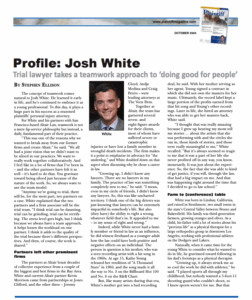In two recent cases, Altair Law partners Craig Peters and Jeremy Cloyd showed the role of defective products in workplace injuries and overcame attempts to blame the victims. In both cases, the injured worker’s employer and others faulted the injured employee for not protecting himself from workplace hazards.
But California recognizes the unfairness of blaming workers for injuries caused by unsafe work conditions. “In some instances [the worker] may find himself powerless to abandon the task at hand with impunity whenever he senses a possible danger; in others, he may be uncertain as to which person has supervision of the job or control of the place of employment, and therefore unsure as to whom he should direct his complaint; in still others, having been encouraged to continue working under conditions where danger lurks but has not materialized, he may be baffled in making an on-the-spot decision as to the imminence of harm. All of these factors enter into a determination whether his conduct falls below a standard of due care.” Gyerman v. United States Lines Co. (1972) 7 Cal.3d 488, 501.
In the first case, a 35-year-old factory worker, Michael, had his hand on a piece of corrugated cardboard ready to be fed into a box-making machine. While Michael was adjusting the machine, it suddenly pulled the cardboard – and Michael’s hand – into it.

Although the box-making machine was equipped with a guard to block hands and fingers, Michael’s hand fit under the guard and contacted a pinch point. Michael’s hand was crushed between two large rollers. He sustained permanent, disabling injuries that prevented him from returning to work.

Michael’s employer and coworkers blamed Michael for his injuries for having his hand near the machine’s moving parts. Altair Law’s investigation found that the machine’s guard left a gap larger than allowed under applicable standards, including OSHA and the European standards where the machine was manufactured. Altair Law discovered that the manufacturer had promised the machine would comply with standards but failed to do so.
In the second case, a 61-year-old truck driver, Craig, was carrying materials at a construction yard when a coworker operating a piece of heavy equipment backed up over and onto Craig’s right leg, ultimately leading to its amputation. Craig’s employer blamed him and his coworker for not keeping a proper lookout and for not using a spotter.

Using a combination of witness statements, physical evidence, and 3D laser scan models, Altair Law showed that the equipment operator reasonably believed his path was clear because the machine was designed with a blind spot. Under California law, such evidence that a product’s design was a cause of injury shifts the burden to the manufacturer to prove “the benefits of the challenged design outweigh the risk of danger inherent in such design.” Kim v. Toyota Motor Corp. (2018) 6 Cal.5th 21, 30. Altair Law showed that the manufacturer could not meet this burden because of the availability of simple and inexpensive alternative designs that would have eliminated the blind spot and avoided Craig’s disabling injury. Altair Law also elicited testimony from the machine’s distributor that spotters were not typically used.

Both cases demonstrate that there can sometimes be a rush to pre-judge an injured worker as being responsible for their injuries. However, a thorough investigation of the facts and understanding of products liability law can lead to a more equitable assignment of fault and help workers receive compensation for career-ending injuries.


